#3D Bounding Boxes/ Cuboids Annotation
Explore tagged Tumblr posts
Text
https://pixelannotation.com/3d-bounding-box-annotation/
0 notes
Text
Title: Image Annotation Services Explained: Tools, Techniques & Use Cases
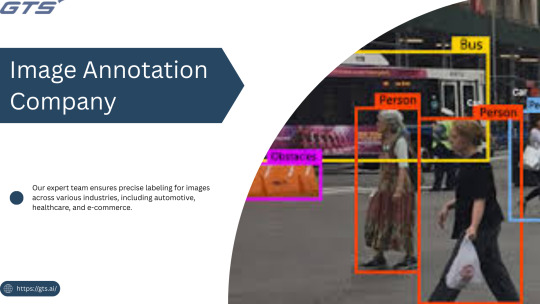
Introduction
In the fast-paced realm of artificial intelligence, Image Annotation Company serve as the foundation for effective computer vision models. Whether you are creating a self-driving vehicle, an AI-driven medical diagnostic application, or a retail analytics solution, the availability of high-quality annotated images is crucial for training precise and dependable machine learning models. But what precisely are image annotation services, how do they function, and what tools and methodologies are utilized? Let us explore this in detail.
What Is Image Annotation?
Image annotation refers to the practice of labeling or tagging images to facilitate the training of machine learning and deep learning models. This process includes the identification of objects, boundaries, and features within images, enabling AI systems to learn to recognize these elements in real-world applications. Typically, this task is carried out by specialized image annotation firms that employ a combination of manual and automated tools to guarantee precision, consistency, and scalability.
Common Image Annotation Techniques
The appropriate annotation method is contingent upon the specific requirements, complexity, and nature of the data involved in your project. Among the most prevalent techniques are:
Bounding Boxes:
Utilized for identifying and localizing objects by encasing them in rectangular boxes, this method is frequently applied in object detection for autonomous vehicles and security systems.
Polygon Annotation:
Best suited for objects with irregular shapes, such as trees, buildings, or road signs, this technique allows for precise delineation of object edges, which is essential for detailed recognition tasks.
Semantic Segmentation:
This approach assigns a label to every pixel in an image according to the object class, commonly employed in medical imaging, robotics, and augmented/virtual reality environments.
Instance Segmentation:
An advancement over semantic segmentation, this method distinguishes between individual objects of the same class, such as recognizing multiple individuals in a crowd.
Keypoint Annotation:
This technique involves marking specific points on objects and is often used in facial recognition, human pose estimation, and gesture tracking.
3D Cuboids:
This method enhances depth perception in annotation by creating three-dimensional representations, which is vital for applications like autonomous navigation and augmented reality.
Popular Image Annotation Tools
Image annotation can be executed utilizing a diverse array of platforms and tools. Notable examples include:
LabelImg: An open-source tool designed for bounding box annotations,
CVAT: A web-based application created by Intel for intricate tasks such as segmentation and tracking,
SuperAnnotate: A robust tool that merges annotation and collaboration functionalities,
Labelbox: A comprehensive platform featuring AI-assisted labeling, data management, and analytics,
VGG Image Annotator (VIA): A lightweight tool developed by Oxford for efficient annotations.
Prominent annotation service providers like GTS.AI frequently employ a blend of proprietary tools and enterprise solutions, seamlessly integrated with quality assurance workflows to fulfill client-specific needs.
Real-World Use Cases of Image Annotation
Image annotation services play a vital role in various sectors, including:
Autonomous Vehicles
Object detection for identifying pedestrians, vehicles, traffic signs, and road markings.
Lane detection and semantic segmentation to facilitate real-time navigation.
Healthcare
Annotating medical images such as X-rays and MRIs to identify tumors, fractures, or other abnormalities.
Training diagnostic tools to enhance early disease detection.
Retail and E-commerce:
Implementing product identification and classification for effective inventory management.
Monitoring customer behavior through in-store camera analytics.
Agriculture:
Assessing crop health, detecting pests, and identifying weeds using drone imagery.
Forecasting yield and optimizing resource allocation.
Geospatial Intelligence:
Classifying land use and mapping infrastructure.
Utilizing annotated satellite imagery for disaster response.
Why Work with a Professional Image Annotation Company?
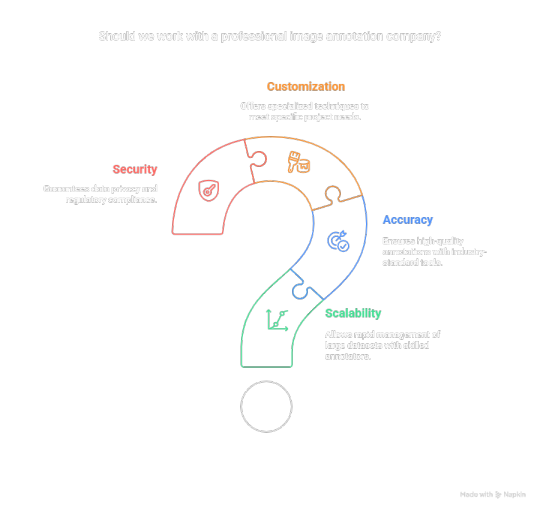
Although in-house annotation may initially appear feasible, expanding it necessitates significant time, resources, and a comprehensive quality assurance process. This is the reason businesses collaborate with providers such as GTS.AI:
Scalability : Allows for the rapid management of extensive datasets through skilled annotators;
Accuracy : Is ensured with industry-standard tools and quality assurance measures;
Customization : Coffers specialized annotation techniques to meet specific project objectives; and
Security : Guarantees adherence to data privacy regulations for sensitive data.
Final Thoughts
With the expansion of AI and computer vision applications, the necessity for high-quality annotated data has become increasingly vital. Image annotation services have evolved from being merely supportive functions to becoming strategic assets essential for developing dependable AI systems. If you aim to enhance your AI projects through professional data labeling, consider Globose Technology Solution .AI’s Image and Video Annotation Services to discover how they can effectively assist you in achieving your objectives with accuracy, efficiency, and scalability.
0 notes
Text
Video Annotation Services: Enhancing AI with Superior Training Data
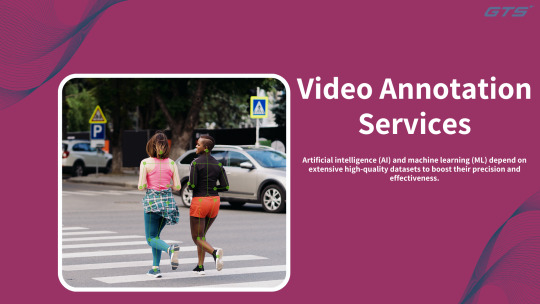
Introduction:
Artificial intelligence (AI) and machine learning (ML) depend on extensive high-quality datasets to boost their precision and effectiveness. A vital aspect of this endeavor is Video Annotation Services, a method employed to label and categorize various objects, actions, and events within video content. By supplying AI models with meticulously annotated video data, organizations can refine their AI solutions, rendering them more intelligent and dependable.
What is Video Annotation?
Video annotation refers to the process of appending metadata to video frames to facilitate the training of AI and ML algorithms. This process includes tagging objects, monitoring movements, and supplying contextual information that aids AI systems in comprehending and interpreting visual data. It is crucial for various applications, including autonomous driving, medical imaging, security surveillance, and beyond.
The Importance of High-Quality Training Data
The performance of AI models is significantly influenced by the quality of the data utilized for training. Inaccurately labeled or subpar data can result in erroneous predictions and unreliable AI outcomes. High-quality video annotation guarantees that AI models can:
Precisely identify and categorize objects.
Monitor movements and interactions within a scene.
Enhance real-time decision-making abilities.
Minimize errors and reduce false positives.
Essential Video Annotation Techniques
Bounding Boxes – These are utilized to outline objects within a video frame using rectangular shapes.
Semantic Segmentation – This technique involves labeling each pixel in a frame to achieve precise object identification.
Polygon Annotation – This method creates accurate boundaries around objects with irregular shapes.
Keypoint and Landmark Annotation – This identifies specific points on objects, facilitating facial recognition and pose estimation.
3D Cuboid Annotation – This technique incorporates depth information for artificial intelligence models applied in robotics and augmented/virtual reality environments.
The Role of Video Annotation Services in Advancing AI Applications
Autonomous Vehicles
Video annotation plays a vital role in training autonomous vehicles to identify pedestrians, other vehicles, traffic signals, and road signs.
Healthcare and Medical Imaging
AI-driven diagnostic tools depend on video annotation to identify irregularities in medical scans and to observe patient movements.
Security and Surveillance
AI-enhanced surveillance systems utilize annotated videos to recognize suspicious behavior, monitor individuals, and improve facial recognition capabilities.
Retail and Customer Analytics
Retailers employ video annotation to study customer behavior, monitor foot traffic, and enhance store layouts.
Reasons to for Professional Video Annotation Services
Engaging expert video annotation services offers several advantages:
Enhanced Accuracy – Skilled annotators deliver meticulous data labeling, minimizing errors during AI training.
Scalability – Professional services are equipped to manage extensive datasets with ease.
Cost Efficiency – Outsourcing annotation tasks conserves time and resources by negating the necessity for internal annotation teams.
Tailored Solutions – Customized annotation methods designed for specific sectors and AI applications.
Your Reliable Partner for Video Annotation
At we offer premier video annotation services aimed at equipping AI with high-quality training data. Our expert team guarantees precise and scalable annotations across diverse industries, assisting businesses in developing more intelligent AI models.
Why Select video annotation
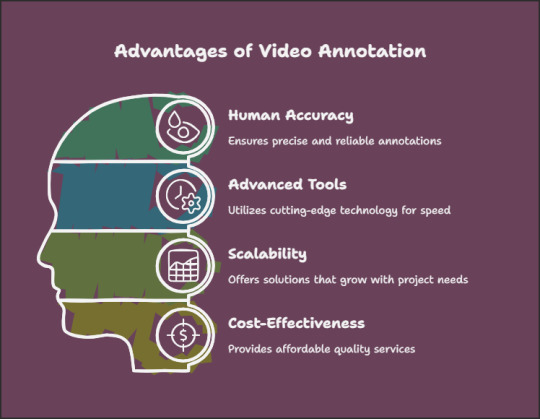
Proficient human annotators ensuring accuracy.
State-of-the-art annotation tools for expedited processing.
Scalable solutions customized to meet your project requirements.
Affordable pricing without sacrificing quality.
In Summary
Video annotation services are fundamental to AI training, ensuring that models are trained on high-quality, accurately labeled data. Whether your focus is on autonomous systems, healthcare AI, or security applications, investing in professional video annotation services like those offered by Globose Technology Solutions will significantly improve the accuracy and effectiveness of your AI solutions.
0 notes
Text
How Data Annotation Companies Improve AI Model Accuracy
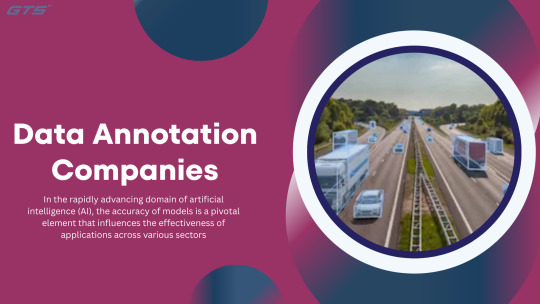
Introduction:
In the rapidly advancing domain of artificial intelligence (AI), the accuracy of models is a pivotal element that influences the effectiveness of applications across various sectors, including autonomous driving, medical imaging, security surveillance, and e-commerce. A significant contributor to achieving high AI accuracy is the presence of well-annotated data. Data Annotation Companies are essential in this process, as they ensure that machine learning (ML) models are trained on precise and high-quality datasets.
The Significance of Data Annotation for AI
AI models, particularly those utilizing computer vision and natural language processing (NLP), necessitate extensive amounts of labeled data to operate efficiently. In the absence of accurately annotated images and videos, AI models face challenges in distinguishing objects, recognizing patterns, or making informed decisions. Data annotation companies create structured datasets by labeling images, videos, text, and audio, thereby enabling AI to learn from concrete examples.
How Data Annotation Companies Enhance AI Accuracy
Delivering High-Quality Annotations
The precision of an AI model is closely linked to the quality of annotations within the training dataset. Reputable data annotation companies utilize sophisticated annotation methods such as bounding boxes, semantic segmentation, key point annotation, and 3D cuboids to ensure accurate labeling. By minimizing errors and inconsistencies in the annotations, these companies facilitate the attainment of superior accuracy in AI models.
Utilizing Human Expertise and AI-Assisted Annotation
Numerous annotation firms integrate human intelligence with AI-assisted tools to boost both efficiency and accuracy. Human annotators are tasked with complex labeling assignments, such as differentiating between similar objects or grasping contextual nuances, while AI-driven tools expedite repetitive tasks, thereby enhancing overall productivity.
Managing Extensive and Varied Data
AI models require a wide range of datasets to effectively generalize across various contexts. Data annotation firms assemble datasets from multiple sources, ensuring a blend of ethnic backgrounds, lighting conditions, object differences, and scenarios. This variety is essential for mitigating AI biases and enhancing the robustness of models.
Maintaining Consistency in Annotations
Inconsistent labeling can adversely affect the performance of an AI model. Annotation companies employ rigorous quality control measures, inter-annotator agreements, and review processes to ensure consistent labeling throughout datasets. This consistency is crucial to prevent AI models from being misled by conflicting labels during the training phase.
Scalability and Accelerated Turnaround
AI initiatives frequently necessitate large datasets that require prompt annotation. Data annotation firms utilize workforce management systems and automated tools to efficiently manage extensive projects, enabling AI developers to train models more rapidly without sacrificing quality.
Adherence to Data Security Regulations
In sectors such as healthcare, finance, and autonomous driving, data security is paramount. Reputable annotation companies adhere to GDPR, HIPAA, and other security regulations to safeguard sensitive information, ensuring that AI models are trained with ethically sourced, high-quality datasets.
Reasons to opt for a Professional Data Annotation Company
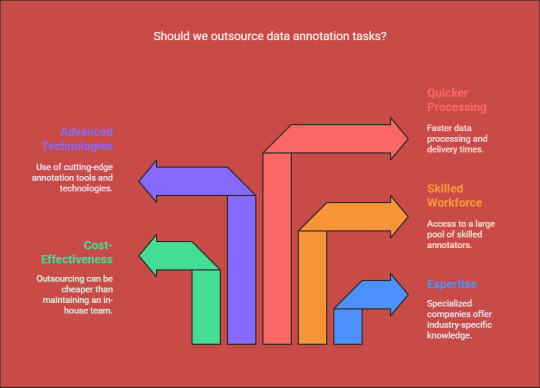
Outsourcing annotation tasks to a specialized company offers several benefits over relying on in-house teams:
Expertise in specific industry annotations
Cost-effective alternatives to establishing an internal annotation team
Access to a skilled workforce and advanced annotation technologies
Quicker data processing and delivery
Conclusion
Data annotation companies are essential for enhancing the accuracy of Globose Technology Solutions AI models through the provision of high-quality, meticulously labeled training datasets. Their proficiency in managing extensive, varied, and intricate annotations greatly boosts model performance, thereby increasing the reliability and effectiveness of AI applications. Collaborating with a professional annotation service provider enables businesses to expedite their AI development while maintaining optimal precision and efficiency.
0 notes
Text
Video Annotation: Empowering AI with Actionable Visual Data
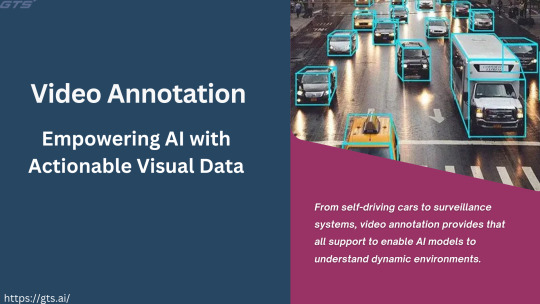
It is the known truth that AI thrives on data, and with computer vision, video data assumes center stage. But just any raw video footage is not what you want for training machine learning models involving recognition of intricate visual environments. This is where video annotation slowly comes into play-dictating the means of converting unstructured video content into actionable labeled data that completes the loop of AI-based applications.
From self-driving cars to surveillance systems, video annotation provides that all support to enable AI models to understand dynamic environments. In this article, we'll explore what video annotation is about, its process, challenges, and how it can change the AI landscape.
What is Video Annotation?
Video annotation is the method of tagging a video with meaningful metadata that lets machine learning models identify, predict, and even recognize objects, motions, or activities taking place in the video. This process allows AI systems to use video data within a real-life context when making interpretations.
Depending on the sophistication of the task, annotated videos may come in different forms, such as bounding boxes, polygons, key points, or semantic segmentation. These labels provide the AI with structured information that lets it learn how objects are spatially related, their trajectories, and the evolution of temporal relationships among video frames.
The Importance of Video Annotation in AI
Video annotation is vital for building a bridge between one piece of video footage and functional AI models. Here is why it is a necessary:
Enabling Object Detection and Tracking: Through annotated video data, AI models can actually identify and trace objects across different frames. Such ability is critical when creating and implementing such systems as self-driving cars, where the system should be able to observe a moving object such as a pedestrian, vehicles, and road signs all at once.
Improved Action Recognition: AI systems trained with annotated video data could identify and categorize every human activity. This opens new avenues for sports analysis, security, and even healthcare in areas like fall detection for elderly persons.
Enhanced Predictive Capabilities: Annotations assist the models in learning temporal sequences that can help in inferring events based on observed trends. In traffic monitoring, AI predicts congestion trends and alerts highway patrol officers of incidents.
Supporting Real-Time Decision Making: Annotation in video data ensures an AI decision-making capability in real-time with scenarios built around drone piloting or robotic surgery, and in turn lessens the risk considerably.
Video Annotation Techniques
How videos are annotated is determined by the needs of the AI model and the complexity of visual data being considered. Some standard techniques include:
Bounding Boxes: Bounding boxes are used to mark out objects in the video. They give a rectangular boundary to the object, which works best for applications like detection and tracking of the object.
Polygon Annotation: For a more irregular shape of the object, polygon provides a more accurate boundary. This helps greatly in detecting complex shapes or crowded scenes.
Key Point Annotation: Key points are specific features such as facial landmarks, joint positions, or edges of the object to be tracked. This is very useful in pose estimation and activity recognition.
Semantic Segmentation: In this, every pixel in a frame of the video is assigned a class label, giving detailed context for activities such as mobile navigation and environment mapping.
3D Cuboids: Cuboids extend the annotation in three dimensions, thus allowing AI systems to view depth and understand 3D spatial relations.
Challenges of Video Annotation
Despite being critical, video annotation presents peculiar challenges:
High Resource Demand: Annotating video data is exhausting and resource-intensive, considering that every frame needs to be labeled. With most sophisticated AI models needing, by and large, a few thousand hours of footage to be annotated.
Ensuring Consistency: Consistency across annotations is vital for avoiding confusion for the model. Variation in labeling guidelines or human error may create a negative impact on model accuracy.
Dealing with Complexity: Occlusions, low lights, and cluttered environments exist in whatever video data come from the real world to contribute further challenges to the final quality of annotation.
Privacy Concerns: When dealing with sensitive video material like surveillance or medical footage, it is important to follow laws of data protection and privacy for the annotation process.
Best Practices for Effective Video Annotation
With great anticipation, these best practices should be followed by organizations, helping overcome those challenges and lead to a final high-quality annotated output:
Develop Clear Guidelines: Consistency starts with a well-defined set of instructions for annotators. This minimizes ambiguity and improves accuracy.
Leverage Automation: Use AI-powered annotation tools to automate repetitive tasks, such as object tracking, thus lessening the burden placed on human annotators.
Train Annotators: Good annotators are crucial in helping to tackle the complexities offered, ensuring that their job is aligned with the project objectives.
Quality Checks: Strong validation and vetting must be executed to check for apparent mistakes that should have been otherwise caught.
Diverse Data Sharing: Annotate videos from various settings, such as medical, pedestrian, and so forth, to enhance the models' generalizability.
Applications of Video Annotation in AI
Video annotation has made unbeatable advances in multiple industries:
Autonomous Vehicles: Annotated videos help self-driving systems to detect and respond to the state of roads, obstacles, and pedestrians.
Healthcare: AI models trained using annotated medical videos help during surgeries, diagnose conditions, and monitor patients. Retail: Video annotation allows AI-driven analytics to track customer behavior and manage inventory.
Security and Surveillance: Annotated footage used to train models for real-time identification of suspicious activities or face recognition.
Entertainment: Annotated videos help AI work to analyze movements during a competitive sporting event to give coaches actionable insights.
The Future of Video Annotation in AI
As the technology behind AI continues to develop, the role of video annotation is going to keep expanding. New trends include:
Real-Time Annotation: With new tools and algorithms being developed, annotations are able to go in real-time and thus speed up model training by a great degree.
Crowdsourced Annotations: New platforms engaging thousands of annotators are helping to combat very large datasets.
Synthetic Data Generation: AI can now produce synthetic annotated video data, thus decreasing the reliance on real-world shooting.
Conclusion
Video annotation provides a bridge between raw visual data and actionable AI. By bringing context and structure into videos, video annotation enables machine learning models to interpret dynamic environments accurately.
With the evolution of both tools and the techniques, video annotation is going to stay put and become pivotal in unlocking new capabilities and stretching the boundaries of the employers of intelligent systems.
Visit Globose Technology Solutions to see how the team can speed up your video annotation projects.
0 notes
Text
Enhancing the Accuracy of AI Models through Superior Image Annotations.
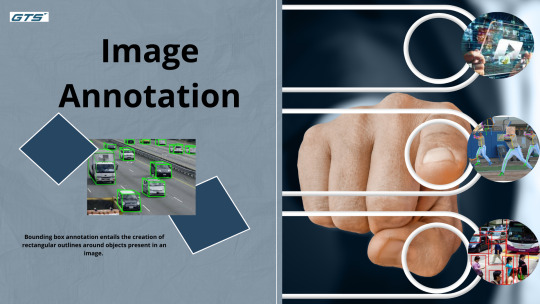
Introduction:
In the era of artificial intelligence and machine learning, image annotation is essential for enabling machines to perceive and comprehend the world in a manner akin to human understanding. This capability is vital for applications ranging from autonomous vehicles to facial recognition technologies and medical diagnostics, as the effectiveness of AI models in interpreting images is significantly dependent on the quality of the annotation provided.
What is Image Annotation?
Image Annotation refers to the practice of assigning metadata to images to facilitate the training of machine learning models. By identifying and labeling objects, regions, or characteristics within an image, annotation aids AI systems in recognizing patterns, distinguishing objects, and generating accurate predictions.
Various annotation techniques include:
Bounding Boxes: Enclosing objects within rectangles to assist AI in their detection.
Semantic Segmentation: Classifying each pixel in an image for detailed analysis.
Polygons and Key Points: Employed for identifying irregular shapes and landmarks in facial recognition tasks.
3D Cuboids: Assists AI models in grasping depth and the dimensions of objects.
Polyline Annotation: Utilized in lane detection for self-driving vehicles.
Why is Image Annotation Important?
Without adequately labeled data, machine learning models face challenges in effectively learning patterns. High-quality annotation guarantees:
Improved Accuracy: Superior training data results in more accurate AI predictions.
Enhanced Automation: Facilitates AI-driven automation across various sectors, including healthcare, retail, and transportation.
Safety and Reliability: Crucial for AI applications such as autonomous vehicles, where precision is paramount.
Types of Image Annotation Techniques
A variety of annotation techniques address distinct needs and complexities associated with image data.
Bounding Box Annotation
Bounding box annotation entails the creation of rectangular outlines around objects present in an image. This method is extensively utilized for object detection tasks, facilitating the identification and localization of objects within a scene. Bounding boxes are particularly advantageous for detecting objects with regular geometries and are computationally efficient for training models.
Semantic Segmentation
Semantic segmentation involves assigning a class label to each individual pixel in an image, which allows for a comprehensive understanding of the scene. This technique is vital for applications that demand precise localization, such as autonomous driving, where it is critical to differentiate between roads, sidewalks, and obstacles. Semantic segmentation offers pixel-level classification, enabling models to grasp the context and interrelations among various objects within an image.
Polygon Annotation
Polygon annotation consists of delineating objects with irregular shapes by utilizing a series of connected points to form a polygonal boundary. This approach provides enhanced accuracy for annotating complex objects compared to bounding boxes, as it closely adheres to the contours of the object. Polygon annotation is particularly useful for tasks that require precise object localization, such as in medical imaging and satellite imagery analysis.
Keypoint Annotation
Keypoint annotation identifies specific points of interest within an object, such as facial landmarks (eyes, nose, mouth) or joint positions in human pose estimation. This technique is crucial for applications like facial recognition, gesture recognition, and activity analysis, where understanding the spatial arrangement of key features is essential.
Cuboid Annotation
Cuboid annotation expands bounding boxes into three dimensions, offering depth information regarding objects.
Numerous sectors gain advantages from image annotation, such as:
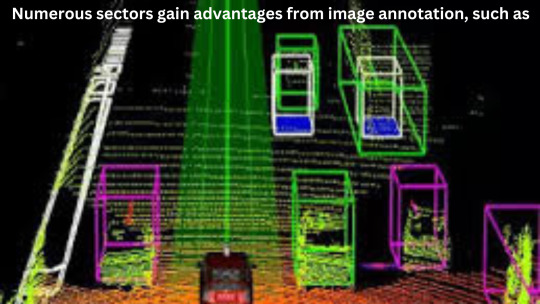
Healthcare: AI-driven diagnostics, tumor identification, and analysis of medical imaging.
Autonomous Vehicles: Lane identification, recognition of pedestrians, and detection of obstacles.
Retail and E-commerce: Visual search capabilities, product classification, and virtual fitting experiences.
Agriculture: Monitoring of crops, identification of pests, and forecasting of yields.
Selecting an Appropriate Image Annotation Partner
For organizations aiming to incorporate AI, collaborating with a specialized annotation service like GTS AI can significantly enhance outcomes. Professional annotation services offer:
Scalability: Efficient management of extensive data volumes.
Quality Assurance: Guaranteeing accurate and uniform annotations.
Security and Compliance: Safeguarding sensitive information through adherence to industry-standard security protocols.
Conclusion
Image annotation serves as the cornerstone of advancements in computer vision and AI. Whether engaged in medical AI, autonomous vehicle technology, or e-commerce solutions, high-quality annotation is crucial for optimal AI model performance. Investing in expert annotation services enables businesses to fully harness the potential of AI and maintain a competitive Globose Technology Solutions.
0 notes
Text
The Role of an Image Annotation Company in Enhancing AI Precision

Introduction
The effectiveness of Artificial Intelligence (AI) is fundamentally dependent on the quality of the data it processes, with Image Annotation Company being pivotal in elevating AI precision. Whether in autonomous vehicles, medical diagnostics, or online retail, AI systems require accurately labeled images to operate optimally. This is where an image annotation company can significantly contribute.
The Significance of Quality Image Annotation
For AI to accurately interpret and analyze visual information, it necessitates labeled images that convey valuable insights. High-quality annotations enable machine learning models to:
Precisely identify objects.
Distinguish between similar items.
Recognize anomalies in intricate settings.
Enhance decision-making based on real-world contexts.
Methods to Improve AI Precision
An image annotation company utilizes a variety of methods to boost AI precision, including:
Bounding Boxes: Essential for object detection, bounding boxes assist AI models in identifying and locating objects within images.
Semantic Segmentation: This technique divides an image into various regions, allowing AI to recognize distinct objects and comprehend contextual relationships.
Key Points and Landmark Annotation: Crucial for applications in facial recognition and pose estimation.
3D Cuboids: Employed in autonomous vehicles and robotics to facilitate depth perception and spatial awareness.
Polygon Annotation: For objects with irregular shapes, polygons provide detailed outlines, enhancing accuracy in object recognition.
The Impact of Image Annotation on AI Performance
AI models require extensive labeled data to refine their algorithms and reduce errors. By collaborating with an image annotation company, organizations can:
Improve Model Training: Well-annotated images accelerate AI learning and enhance accuracy.
Mitigate Bias in AI: Ensuring diverse and unbiased datasets fosters fairer AI predictions.
Boost Automation Efficiency: High-quality data annotations enhance the effectiveness of AI automation.
Industries Benefiting from Image Annotation
The demand for accurate image annotation is prevalent across various sectors:
Autonomous Vehicles – Self-driving cars powered by artificial intelligence depend on annotated images for tasks such as object recognition, lane detection, and identifying pedestrians.
Healthcare & Medical Imaging – Annotated medical images, including X-rays, MRIs, and CT scans, play a crucial role in diagnosing diseases and facilitating medical assessments.
Retail & E-Commerce – Features like product tagging and visual search enhance the online shopping experience for consumers.
Agriculture – AI-based solutions for monitoring crops, detecting pests, and predicting yields are supported by annotated images in the agricultural sector.
Why Collaborate with an Image Annotation Company?
Collaborating with a specialized image annotation company guarantees high levels of accuracy, consistency, and scalability. Professional annotation services offer:
Access to experienced annotators with relevant industry knowledge.
State-of-the-art annotation tools and rigorous quality control processes.
Scalable solutions capable of efficiently managing large datasets.
Conclusion
Artificial intelligence models significantly depend on well-annotated images to operate effectively. By partnering with a professional image annotation company, organizations can ensure their AI systems are equipped with high-quality data, resulting in enhanced accuracy, improved decision-making, and greater efficiency. Whether in healthcare, automotive, or retail, investing in superior image annotation is essential for realizing the full potential of AI.
How GTS.AI Make Your Project Complete?
Globose Technology Solutions is integral to our professional environment, offering high-quality, scalable, and accurate image annotation solutions that support AI models across various sectors. Its sophisticated annotation tools—including bounding boxes, semantic segmentation, and 3D cuboids—guarantee precision in training datasets for applications such as autonomous vehicles, healthcare diagnostics, and e-commerce. By utilizing AI-assisted annotation, automated quality control, and a proficient workforce, gts.ai improves efficiency, minimizes bias, and expedites AI development. Its cloud-based workflow facilitates seamless collaboration, enhancing the reliability and effectiveness of AI training, and ultimately influencing the future of intelligent automation.!
1 note
·
View note
Text
Image Data Annotation for Agriculture: Revolutionizing Crop Monitoring
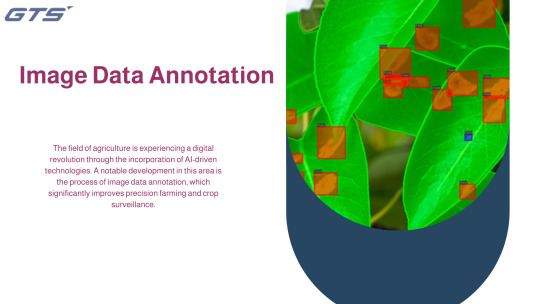
Introduction
The field of agriculture is experiencing a digital revolution through the incorporation of AI-driven technologies. A notable development in this area is the process of Image Data Annotation, which significantly improves precision farming and crop surveillance. Utilizing annotated images from agriculture, AI models are capable of assessing crop health, identifying diseases, and refining yield predictions.
What is Image Data Annotation in Agriculture?
Image data annotation in agriculture refers to the process of labeling visual information, including satellite imagery, drone captures, and photographs of fields, to facilitate the training of machine learning models tailored for agricultural purposes. These annotations enable artificial intelligence systems to detect patterns, classify crop types, and evaluate field conditions with a high degree of precision.
Categories of Image Data Annotation in Agriculture:
1. Bounding Box Annotation – This method identifies plants, weeds, and pests to enable automated detection.
2. Semantic Segmentation – This technique distinguishes between crops, soil, and weeds within an image.
3. Keypoint Annotation – This approach marks essential points on plants to monitor their growth.
4. Polygon Annotation – This method provides accurate outlines of fields and crop areas.
5. 3D Cuboid Annotation – This technique assists in estimating the height and structure of plants.
How Image Data Annotation is Transforming Crop Monitoring
1. Enhanced Crop Health Assessment
AI-driven models utilize annotated images to identify early indicators of diseases, nutrient shortages, and pest problems, allowing farmers to take timely action.
2. Identification of Weeds and Pests
Automated systems for weed detection leverage annotated datasets to differentiate between crops and harmful plants, minimizing the necessity for manual weeding and reducing pesticide application.
3. Yield Forecasting and Harvest Efficiency
Through the analysis of annotated images, AI models can project crop yields, enabling farmers to organize harvest timelines effectively and enhance overall productivity.
4. Targeted Irrigation and Soil Assessment
Image data annotation aids AI-based irrigation systems by monitoring soil moisture and plant hydration levels, promoting efficient water management.
5. Adaptation to Climate and Weather Changes
Utilizing annotated climate and weather data, AI models can foresee unfavorable conditions, assisting farmers in taking preventive actions against droughts or severe weather events.
The Importance of Professional Data Annotation Services
High-quality image annotation services, such as those offered by GTS AI, play a crucial role in the effective training of AI models. These services provide:
Scalability – The ability to manage extensive volumes of agricultural data with efficiency.
Accuracy – Superior annotations that enhance the precision of models.
Cost Efficiency – Minimizing manual labor expenses in the agricultural sector.
Customization – Bespoke annotation solutions tailored to meet specific agricultural requirements.
Conclusion
Image data annotation is revolutionizing the agricultural landscape by facilitating AI-driven crop monitoring, disease identification, and yield forecasting. As technological advancements continue, precision farming will further develop, equipping farmers with data-informed insights for sustainable agricultural practices.
For innovative image annotation solutions, consider GTS AI to transform your agricultural AI models today.
0 notes
Text
Top Features of an Image Annotation Tool for AI
In the world of Artificial Intelligence (AI), high-quality data is the backbone of successful projects. For AI models to learn and perform accurately, they require well-annotated datasets. This is where an image annotation tool becomes invaluable. These tools streamline the process of labeling data, enabling teams to create datasets that power cutting-edge AI solutions. But what makes an image annotation tool truly effective? Here’s a look at the top features you should consider when selecting one.
1. Support for Multiple Annotation Types
AI models are used for a variety of applications, from object detection to semantic segmentation. A robust image annotation tool should support multiple annotation types, such as:
Bounding Boxes: Ideal for object detection in autonomous driving or surveillance.
Polygons: Perfect for annotating irregular shapes, such as buildings in satellite imagery.
Key Points: Useful for facial recognition or body posture analysis.
Semantic Segmentation: For pixel-level labeling in medical imaging or robotics.
3D Cuboids: Essential for depth perception in applications like self-driving cars.
The flexibility to choose different annotation types ensures that the tool can cater to diverse project needs.
2. Automation Features
Manual annotation can be a time-consuming process, especially for large datasets. Automation features significantly reduce the effort required by leveraging AI to assist with labeling. Key automation capabilities include:
Auto-labeling: Automatically annotates objects based on predefined criteria.
Pre-labeling: Uses AI to generate initial labels for manual review.
Smart Predictions: Suggests annotations by identifying patterns in existing data.
These features not only save time but also enhance the overall efficiency of the annotation process.
3. Quality Assurance Mechanisms
The quality of annotations directly impacts the performance of AI models. An effective annotation tool includes features to ensure high-quality and consistent labels:
Confidence Scoring: Flags low-confidence annotations for manual review.
Inter-Annotator Agreement: Ensures consistency across multiple annotators.
Error Detection: Identifies anomalies or inconsistencies in the dataset.
These mechanisms help maintain data integrity, resulting in more reliable AI models.
4. Scalability
As datasets grow in size and complexity, scalability becomes a critical factor. A good image annotation tool should be able to handle:
Large datasets without compromising performance.
Seamless cloud-based solutions for storage and collaboration.
The ability to scale as project needs evolve over time.
5. Integration with ML Pipelines
The tool should integrate smoothly with machine learning workflows. This includes:
Data Format Compatibility: Supporting popular formats like COCO, YOLO, or Pascal VOC.
Cloud Platform Integration: Enabling easy data transfer with platforms like AWS, Azure, or GCP.
Seamless integration reduces friction and speeds up the transition from annotation to model training.
6. Collaboration Features
For teams working on large projects, collaboration features are essential. Look for tools that offer:
Real-Time Feedback: Allows annotators and reviewers to communicate efficiently.
Guideline Sharing: Ensures consistent annotations by providing clear labeling instructions.
These features enable teams to work together effectively and maintain high standards.
Conclusion
Choosing an image annotation tool with the right features is essential for the success of any AI project. A tool that supports multiple annotation types, offers automation, ensures quality, and integrates with ML workflows can save time and enhance the accuracy of your datasets.
For a comprehensive solution, explore Labellerr’s image annotation tool. Designed with scalability, efficiency, and collaboration in mind, Labellerr empowers AI teams to create high-quality datasets that drive innovation.
Invest in the right tool today to streamline your AI project and achieve better results tomorrow.
#ArtificialIntelligence#MachineLearning#DataAnnotation#ImageAnnotation#AItools#DataLabeling#ComputerVision#AIInnovation#DeepLearning#AITechnology
0 notes
Text
Shaping Smarter Machines: Image Annotation in the Digital Era
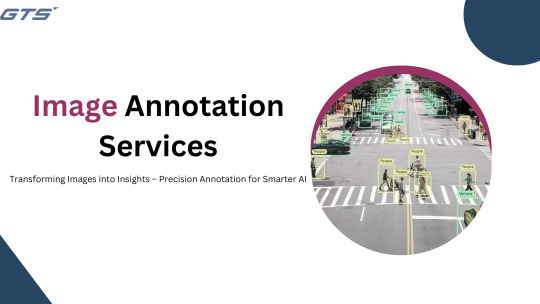
Introduction:
In the contemporary digital landscape, the distinction between human intelligence and artificial intelligence (AI) is increasingly indistinct as machines evolve to become more intelligent, rapid, and efficient. Central to this evolution is a vital yet frequently overlooked process: Image Annotation Services . This detailed practice forms the foundation of AI’s capacity to analyze, comprehend, and react to visual information. This article will delve into the essential function of image annotation in the development of advanced machines and its influence on the future of technology.
What Is Image Annotation?
Image annotation refers to the technique of tagging images with metadata to render them comprehensible to machines. This process includes marking objects, identifying characteristics, or delineating boundaries within an image, thereby converting raw data into formats that machines can interpret. These annotations provide the training data necessary for machine learning models, particularly in domains such as computer vision, where the ability to understand visual content is critical.
Common types of image annotation encompass:
Bounding Boxes: Drawing rectangles around objects to indicate their position.
Semantic Segmentation: Segmenting an image into parts to assign labels to individual pixels.
Polygons: Outlining intricate shapes for precise object detection.
Keypoint Annotation: Identifying specific points, such as facial features or joint locations.
3D Cuboids: Extending bounding boxes into three dimensions for depth analysis. Each type of annotation is tailored to specific machine learning applications, enabling AI systems to recognize faces, detect objects, or even facilitate the navigation of autonomous vehicles.
The Significance of Image Annotation
Annotated data is essential for AI systems, as it provides the necessary context to interpret visual information effectively. Without it, machines face challenges similar to navigating an unfamiliar country without a map or language comprehension. Image annotation serves as a crucial link by supplying structured and labeled data, allowing machines to recognize patterns and relationships.
The primary advantages of image annotation include:
Improving Accuracy: Annotated datasets enhance the precision of models, thereby minimizing errors in tasks such as object detection and image classification.
Preparing AI for Practical Use: From self-driving vehicles to medical imaging, annotated images equip AI systems for real-world applications.
Facilitating Scalability: High-quality annotations enable the expansion of AI applications across various industries.
The Role of Image Annotation in Contemporary Digital Applications
The influence of image annotation extends across multiple sectors, acting as a catalyst for innovative advancements:
Autonomous Vehicles: Self-driving technology depends on annotated images to recognize pedestrians, vehicles, traffic signs, and road boundaries. This annotation is vital for enabling these systems to make rapid decisions, thereby improving safety and operational efficiency.
Healthcare: In the realm of medical imaging, annotated data assists AI models in identifying diseases such as cancer and diabetic retinopathy. Collaboration between radiologists and data scientists is essential for labeling anomalies in scans, which leads to faster and more accurate diagnoses.
E-Commerce: Retailers utilize image annotation for tailored recommendations, visual search capabilities, and inventory management. For instance, AI can analyze user-uploaded photos to identify clothing items and suggest similar products.
Agriculture: Annotated images play a significant role in monitoring crop health, identifying pests, and maximizing yields. Drones equipped with AI technology analyze annotated visual data to deliver actionable insights to farmers.
Security and Surveillance: Annotated images are integral to facial recognition systems and anomaly detection in security cameras, enhancing monitoring capabilities.
Challenges in Image Annotation
The significance of image annotation is clear; however, it presents several challenges:
Labor-Intensive Nature: The process of annotating extensive datasets demands considerable time and careful attention to detail.
Financial Implications: Engaging professional annotation services can incur substantial costs, particularly for intricate tasks.
Variability in Interpretation: Different human annotators may perceive images in various ways, resulting in inconsistencies.
Scalability Concerns: As datasets expand, ensuring quality and uniformity becomes progressively more difficult.
Addressing these challenges necessitates a blend of proficient annotators, advanced technological tools, and comprehensive quality assurance measures. The integration of automation and semi-automated tools, driven by artificial intelligence, is increasingly vital in optimizing annotation workflows.
The Future of Image Annotation
With the ongoing advancement of AI, the domain of image annotation is also evolving. Several trends are influencing its future:
AI-Enhanced Annotation: Tools that utilize AI can automatically pre-label images, minimizing manual labor and accelerating the annotation process. Human annotators subsequently refine these initial labels to ensure precision.
Crowdsourced Solutions: Platforms such as Amazon Mechanical Turk facilitate distributed annotation efforts, leveraging a global workforce to efficiently manage large datasets.
Synthetic Data Generation: The creation of synthetic images, along with programmatic annotation, can supplement real-world datasets, thereby decreasing reliance on manual annotation.
Specialized Annotation Services: Emerging services focused on specific industries are ensuring that annotations align with particular requirements.
Real-Time Annotation Capabilities: As applications requiring real-time AI, such as augmented reality and live surveillance, become more prevalent, the demand for real-time annotation functionalities is increasing.
Conclusion
Image annotation transcends mere technicality; it serves as the cornerstone for the development of advanced machines. By converting visual information into practical insights, it allows artificial intelligence systems to interpret and engage with their environment in groundbreaking manners. As we progress further into the digital age, the necessity for superior image annotation services is expected to escalate, fostering innovation across various sectors and paving the way for a future where intelligent machines are seamlessly woven into our daily lives.
Selecting the right image annotation service is crucial for the success of computer vision projects. Collaborating with experts like Globose Technology Solutions ensures high-quality annotations tailored to project needs, boosting model performance and efficiency. Opting for specialized providers combines expertise with scalability, making them ideal for handling complex datasets.
0 notes
Text
Image Annotation: Why Choosing the Right Company Matters
Image annotation is crucial for training AI models, enabling them to recognize and classify objects within images. Choosing the right image annotation company is essential for ensuring high-quality, accurately labeled data. Companies like GTS.AI specialize in providing comprehensive annotation services, including bounding boxes, semantic segmentation, and 3D cuboids, tailored to meet diverse project needs. With expertise across industries like healthcare and autonomous vehicles, GTS.AI ensures precise, scalable solutions, leveraging advanced tools and rigorous quality control. Partnering with GTS.AI enhances the performance of your AI models by providing the reliable, well-annotated data they need to learn and succeed, making GTS.AI a trusted partner in the rapidly growing field of data annotation. https://gts.ai/services/image-and-video-annotation/
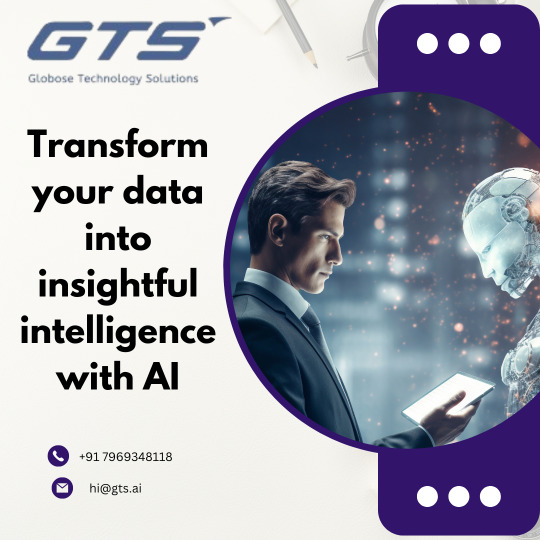
0 notes
Text
Why AI Annotation is Critical for Computer Vision Success

Introduction
In the swiftly advancing realm of Artificial Intelligence Annotation , computer vision has become one of the most transformative technologies. It facilitates the interpretation and comprehension of visual data by machines, playing a crucial role in applications ranging from self-driving cars to facial recognition systems. Nevertheless, the success of any computer vision model is fundamentally dependent on high-quality AI annotation. In the absence of precisely labeled data, even the most sophisticated AI models are unable to produce dependable outcomes.
The Importance of AI Annotation in Computer Vision
AI annotation, commonly referred to as data labeling, involves the process of assigning metadata to visual data, including images and videos, to assist machine learning models in identifying patterns, objects, and environments. Accurate annotation is essential, as it provides the foundational training necessary for AI algorithms, enabling them to learn effectively and generate precise predictions.
Improving Model Precision The effectiveness of a computer vision model is fundamentally dependent on the quality of the data it is trained on. Inaccurately annotated images can result in erroneous predictions, which can adversely impact performance in critical areas such as medical imaging, surveillance, and robotics. Ensuring high-quality annotations is essential for the model to accurately recognize objects and reduce the likelihood of mistakes.
Facilitating Object Detection and Identification Applications powered by artificial intelligence, including autonomous vehicles and automated retail checkout systems, depend heavily on the capabilities of object detection and identification. Methods such as bounding box annotation are employed to accurately delineate objects within images, enabling AI models to differentiate between various entities. For example, in the context of self-driving cars, precise annotation is crucial for the vehicle to effectively recognize pedestrians, traffic signs, and potential obstacles. Discover more about bounding box annotation services here.
Enhancing the Efficiency of Model Training The training of artificial intelligence models necessitates extensive datasets, and the manual labeling of images can be a labor-intensive task. The use of efficient annotation tools and automated labeling methods accelerates this process while preserving accuracy. Improved annotation practices enable AI models to achieve optimal performance with fewer training iterations.
Addressing Edge Cases and Uncommon Situations In practical applications, AI systems are required to manage a wide range of scenarios, including those that are rare or unforeseen. Thorough AI annotation plays a crucial role in capturing a variety of examples, thereby ensuring that the model can effectively generalize across different situations and environments.
AI Annotation Techniques for Computer Vision
Various AI annotation techniques are employed to improve model efficacy:
Bounding Boxes: Rectangles are drawn around objects to assist AI in their detection.
Semantic Segmentation: Each pixel in an image is labeled to facilitate detailed recognition.
Landmark Annotation: Key points on objects, including facial features or body joints, are marked.
Polygon Annotation: Irregularly shaped objects are outlined for enhanced detection accuracy.
3D Cuboid Annotation: This method aids AI in understanding depth and perspective within images.
The Future of AI Annotation in Computer Vision
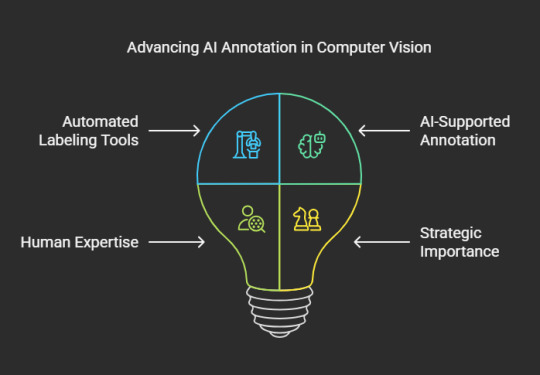
As artificial intelligence progresses, the techniques for annotation are also transforming, incorporating automated labeling tools and AI-supported annotation. Nevertheless, the role of human expertise is essential in enhancing labeled datasets to ensure accuracy and quality control. Organizations that prioritize strong AI annotation strategies will be at the forefront of creating more advanced and efficient computer vision models.
Conclusion
AI annotation serves as the foundation for success in computer vision. The effectiveness of AI models in real-world applications hinges on the availability of accurately labeled data. As various industries become more dependent on AI-powered visual recognition, the need for superior annotation services is expected to rise. For those seeking to improve their AI models through precise bounding box annotation, consider Globose Technology Solutions AI’s offerings to expedite your AI development process.
0 notes
Text
Image Annotation Services: Connecting Raw Data to AI Insights
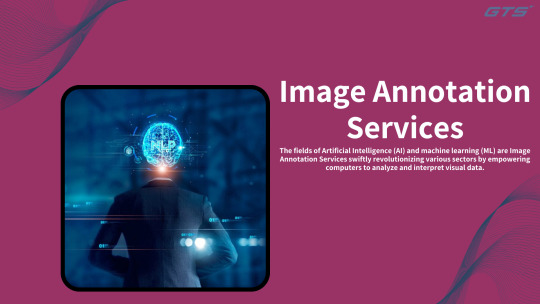
Introduction:
The fields of Artificial Intelligence (AI) and machine learning (ML) are Image Annotation Services swiftly revolutionizing various sectors by empowering computers to analyze and interpret visual data. However, unprocessed images do not offer the structured information necessary for AI to make precise decisions. This is where image annotation services become essential, serving as a link between unrefined image data and valuable AI insights.
Defining Image Annotation
Image annotation involves the process of tagging images with metadata to render them comprehensible for AI algorithms. These tags can identify objects, categorize images, delineate boundaries, or even monitor movements, depending on the specific needs of an AI model. Through accurate annotation, AI systems can identify patterns, recognize objects, and make well-informed decisions with a high degree of precision.
The Significance of Image Annotation for AI
AI models depend on extensive amounts of accurately labeled data for effective learning and enhancement. In the absence of proper image annotation, AI algorithms face challenges in differentiating between objects and accurately interpreting images. The following are some notable advantages of image annotation services:
Increased AI Precision: Well-annotated images facilitate more effective learning for AI, minimizing errors in object detection and classification.
Scalability in AI Development: A substantial volume of labeled data allows AI models to be trained to address a diverse array of real-world situations.
Enhanced Automation: From autonomous vehicles to healthcare diagnostics, annotated images empower AI to automate intricate tasks that necessitate visual recognition.
Improved User Engagement: Technologies such as facial recognition, augmented reality, and e-commerce product suggestions rely on high-quality image annotation to ensure a smooth user experience.
Types of Image Annotation Techniques
Various artificial intelligence applications necessitate distinct annotation techniques. Below are several prevalent types of image annotation utilized in AI training:
Bounding Box Annotation: This method is employed in object detection, where bounding boxes encapsulate objects within an image, facilitating AI in their recognition and classification.
Semantic Segmentation: This approach assigns a label to each pixel in an image, allowing for accurate identification of different areas.
Polygon Annotation: Unlike basic bounding boxes, polygon annotation offers detailed outlines of objects, resulting in more precise labeling.
Keypoint Annotation: This technique is utilized for facial recognition and human pose estimation, marking specific points on an object or human figure.
3D Cuboid Annotation: Vital for applications such as autonomous driving, 3D cuboids enable AI to comprehend depth and spatial relationships.
Applications of Image Annotation Across Industries
Image annotation services play a pivotal role in numerous AI-driven sectors. Some significant applications include:
Autonomous Vehicles: Training self-driving cars to identify pedestrians, traffic signs, and other vehicles.
Healthcare & Medical Imaging: Enhancing AI-based diagnostics through the labeling of X-rays, MRIs, and CT scans.
Retail & E-commerce: Supporting visual search and recommendation systems to improve the shopping experience.
Agriculture: Aiding in crop monitoring, disease detection, and yield estimation through AI-driven analysis.
Security & Surveillance: Enhancing facial recognition and anomaly detection for improved security systems.
Why Opt for Professional Image Annotation Services?
Although some organizations may choose to conduct annotation in-house, utilizing professional image annotation services presents numerous benefits:
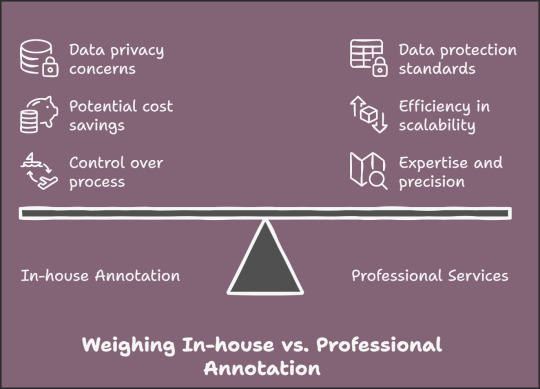
Expertise and Precision: Skilled annotators guarantee accurate labeling, which is crucial for optimal AI functionality.
Efficiency in Time and Costs: By outsourcing annotation tasks, companies can concentrate on AI development while minimizing operational expenses.
Scalability: Professional services are equipped to manage extensive datasets effectively, thereby expediting the AI training process.
Data Protection: Established annotation providers adhere to stringent data privacy standards, safeguarding the confidentiality of sensitive images.
Conclusion
Image annotation services play a vital role in the AI development process, converting unprocessed image data into organized, meaningful information. By connecting raw data with AI insights, these services enable businesses to create more intelligent and efficient AI models across diverse sectors. Whether applied in autonomous vehicles, healthcare, or retail, investing in high-quality image annotation services is a crucial step toward realizing the full potential of AI.
For further information on how image annotation can improve your AI initiative, please visit Globose Technology Solutions AI.
0 notes
Text
Video Data Annotation Techniques for Machine Learning

Introduction:
In the swiftly changing domain of machine learning, the demand for high-quality annotated video data has reached unprecedented levels. Video data annotation refers to the process of assigning metadata to video footage, enabling machine learning models to interpret the content effectively. This essential procedure serves as a cornerstone for training algorithms across a variety of fields, including autonomous vehicles, security surveillance, healthcare diagnostics, and entertainment.
What is Video Data Annotation?
Video Data Annotation entails the tagging of video frames with pertinent labels that assist machine learning models in recognizing objects, actions, and events. Unlike image annotation, which focuses on static images, video annotation must address temporal data, rendering it more intricate and challenging.
Key Video Data Annotation Techniques
Frame-by-Frame Annotation
This technique involves annotating each frame of the video separately. While it is often employed for applications requiring high accuracy, it can be labor-intensive.
Automated Annotation
By utilizing pre-trained models, automated annotation tools can label video data with minimal human involvement. These tools apply computer vision methods to detect and label objects in real-time, thereby accelerating the annotation process.
Bounding Boxes
This widely used technique involves enclosing objects within rectangular boxes. It facilitates the tracking of object movement across frames and is prevalent in applications such as object detection.
Semantic Segmentation
This method assigns a label to every pixel within a frame, offering a more comprehensive understanding of the scene. It is vital for tasks that necessitate precise object boundaries, such as in medical imaging or autonomous driving.
Key Point Annotation
This technique focuses on identifying specific points of interest within an object, such as facial landmarks or joints in the human body. It is crucial for applications involving gesture recognition and pose estimation.
Polyline and Polygon Annotation
These methodologies are employed to annotate irregular shapes and lines, such as road lanes or pathways. Polylines are especially beneficial in autonomous vehicle applications for the purpose of lane detection.
3D Cuboid Annotation
This technique entails the creation of a three-dimensional representation of objects within the video, offering depth information that is vital for applications such as robotics and virtual reality.
Challenges in Video Data Annotation
Volume and Complexity: Video annotation necessitates the management of substantial data volumes and intricate scenes.
Consistency: Ensuring consistency across frames and videos poses a challenge but is crucial for dependable model training.
Time and Cost: Manual annotation is labor-intensive and can incur significant costs, highlighting the necessity for efficient tools and methodologies.
Best Practices for Video Data Annotation

Quality Control: Conducting regular checks and reviews of annotated data is essential to ensure accuracy and consistency.
Tool Selection: The appropriate selection of annotation tools can greatly enhance efficiency and minimize errors.
Training and Guidelines: Providing clear instructions and training for annotators fosters a standardized approach to the annotation process.
Iteration: Ongoing feedback and refinement of annotations contribute to the enhancement of data quality.
Conclusion
Video data annotation serves as a fundamental element of machine learning, facilitating models to learn from dynamic visual content. Globose Technology Solutions By utilizing advanced annotation techniques and addressing the inherent challenges, organizations and researchers can fully harness the potential of video data in artificial intelligence applications.
0 notes
Text
Video Annotation: Transforming Motion into AI-Ready Insights

AI and ML have changed the way people interact with digital content while video annotation is at the focal point of such transformation. It enables everything from detecting pedestrians by autonomous vehicles to real-time checking of threats in surveillance systems, but the interpretation of movement by artificial intelligence is highly dependent on high-quality annotated video data.
In simple terms, it is labeling video frames to add context for AI models. Annotated videos teach AI systems more effectively to identify underlying patterns, behaviors, and environments by marking objects, tracking movement, and defining interactions. Thus, they become smart, fast, and reliable decision-makers.
Why Video Annotation Matters in AI Development
The models that really grow from data are AI, and videos share much richer, dynamic information as compared to static images with no motion. It will provide motion, depth, and continuity, allowing AI to do things like:
Understand movement and object tracking in real-world environments.
Analyze complex interactions between people, objects, and the environment.
Improve decision-making in real-time AI applications.
Enhance accuracy by considering multiple frames rather than isolated snapshots.
These capabilities make video annotation essential for applications ranging from self-driving cars to sports analytics and healthcare diagnostics.
Types of Video Annotation Techniques
The efficiency of any AI model depends on the detail and number of techniques used to annotate the video. Each method caters to a particular type of AI, allowing the model to get exactly the type of data required in its learning process.
Bounding Box Annotation: This method involves drawing rectangular boxes around the objects identified in every frame. Bounding boxes provide an intuitive and effective training method for AI models to detect and recognize objects in the scene.
Semantic Segmentation: Semantic Segmentation is a more complex technique, but it involves the assignment of a category label for every pixel in the frame of a video. With semantic segmentation, the AI reaches a level of understanding of video content that matches that of a human, thus being able to better recognize objects.
Keypoint Annotation: This method usually annotates important points on an object for applications ranging from human pose analysis to face recognition AI. This annotation helps the AI understand body language and gesture by mapping joints and satellite trajectories.
Optical Flow Annotation: The optical flow technique tracks motion in terms of pixel displacement between two adjacent frames. It allows AI models to analyze past trajectories and ascertain the future possibilities of odors.
3D Cuboid Annotation: Unlike bounding boxes, 3D cuboids give depth perception, enabling AI to recognize object dimensions and spatial relationships. This annotation type ensures that AI understands object placement in three-dimensional space.
Challenges in Video Annotation
In spite of their tremendous advantages, video annotation has some annoyances that compromise AI model training farther on.
Huge Volume of Data: Videos contain thousands of frames, making annotation a small-scale arm-bending job. Streamlining the workflow with artificial or AI-assisted annotation could somehow help in this respect.
Motion Blur and Occlusion: Moving objects are magnificently difficult, if not next to impossible, to annotate. This is mainly because they can obscure themselves or become blurred by the movement. Some frame interpolation methods support increased annotation accuracy.
Data Privacy and Compliance: Video content may contain a lot of sensitive data from its very nature. Hence, it is subject to regulations of GDPR, CCPA, and the like. Such proper anonymization methods lead to ethical AI development in practice.
Annotation Consistency: Labeling must be consistent throughout frames and datasets. High variability leads to machine learning bias, so rigorous quality control is necessary.
The Future of Video Annotation in AI
Even as AI improves, techniques will change for video annotation. Various trends in motion analysis of video include:
AI-assisted annotation: Annotating objects with the assistance of AI in an automatic way and less manual effort.
Self-supervised learning: AI learns from unlabeled data off a video.
Real-time annotation: AI easily merges to the live video feed in real-time.
Federated learning: AI models trained over many sources from the edge of the client together, preserving privacy.
These developments will only increase the accuracy of AI, help ensure less training time for AI systems, and support enhanced AI application efficiency.
Conclusion
Video annotation is the backbone of AI-powered motion analysis, as they provide the training data required by machine learning models. With the ability to label objects, movements, and interactions correctly, AI systems can interpret and understand reality with improved accuracy.
From autonomous vehicles and healthcare to sports analytics and retail, video annotation is transforming industries and driving the path to AI innovation for the future. As annotation techniques develop, AI will continue to learn, adapt, and revolutionize the way we interact with visual data.
Visit Globose Technology Solutions to see how the team can speed up your video annotation projects.
0 notes